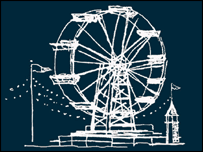Standards
This WebQuest is
based off of both the Pennsylvania State Academic Standards and the
National Council of Teachers of English Standards
Pennsylvania State Academic
Standards
- 1.1.12: Learning to Read
Independently
- D: Identify, describe, and synthesize the essential ideas
in text.
- G: Demonstrate after reading understanding and
interpretation of both fiction and nonfiction text
- 1. Make, and support with evidence, assertions about
texts
- 3. Make extensions to related ideas, topics, or
information
- Students
are required to relate and extend on ideas by choosing a person,
reading information on them, connecting fiction with nonfiction, and
synthesize their ideas into a project form.
- 1.3.12: Reading, Analyzing, and
Interpreting Literature
- A: Read and understand essential content of informational
texts and documents in all academic areas
- Students arerequired to interpret The Five People You Meet in Heaven
in order to successfully complete this project in a separate context
from the novel.
- 1.4.12: Types of Writing
- B: Write complex informational pieces (e.g. research
papers, analyses, essays)
- 1. Include a variety of methods to develop the main idea
- 2: Use precise language and specific detail
- 4: Use relevant graphics (e.g. maps, charts, graphs,
tables, illustrations, photographs.)
- Students are required to write an essay or
construct a creative medium of their project. Either one requires the
student to perform an analysis where precise language and detail is
pertinent. Students need visual aid in order to enhance their own
understanding and audience understanding.
- 1.5.12: Quality of Writing
- A: Write with sharp, distinct focus
- 1: Identify topic, task, and audience
- 2: Establish and maintain a single point of view
- B: Write using well-developed content appropriate for the
topic
- 1: Gather, determine validity and reliability of,
analyze and organize information
- 2: Employ the most effective format for purpose and
audience
- 3: Write fully-developed paragraphs that have details
and information specific to the topic and relevant to the focus
- C: Write with controlled and/or subtle organization
- 1: Sustain a logical order throughout the piece
- 2: Include an effective introduction and conclusion
- D: Write with a command of the stylistic aspects of
composition
- 1: Use different types and lengths of sentences
- 2: Use precise language
- Students are required to practice these
fundamentals of writing in their presentation excerpt and their written
reflection. The gathering of valid content for this project is required
for a successful completion. Students are required to follow specific
procedural steps of the process to enhance organization. Stylistic
composition will be acquired through the student's project synthesis.
- 1.6.12: Speaking and Listening
- A: Listen to others
- 2: Synthesize information, ideas, and opinions to
determine relevancy
- B: Listen to selections of literature (fiction or
nonfiction)
- 1: Relate them to previous knowledge
- 3: Summarize and reflect on what has been heard
- 4: Identify and define new words and concepts
- 5: Analyze and synthesize
- Students are required to complete a
presentation section for this project. This requires the student to
listen to others and also to synthesize and summarize ideas for
relevancy. Students will be required to complete a written reflection
to which the student will summarize on concepts and analytical
knowledge gained from the presentations.
- 1.8.12: Research
- B: Locate information using appropriate sources and
strategies
- 1: Determine valid resources for researching the topic,
including primary and secondary sources
- 2: Evaluate the importance and quality of sources
- 3: Select sources appropriate to the breadth and depth
of the research
- 5: Use traditional and electronic search tools
- C: Organize, summarize, and present the main ideas from
research
- 1: Take notes relevant to the research topic
- 3: Anticipate readers' problems or misunderstandings
- 4: Give precise, formal credit for others' ideas,
images, or information using a standard method of documentation
- 5: Use formatting techniques
- Students are required to complete extensive
research in order to successfully complete this project. The research
must be organized and summarized to where they represent the main ideas
from the cumulated research
NCTE Standards
5. Students employ a wide range of strategies as
they write and use different writing process elements appropriately to
communicate with different audiences for a variety of purposes.
Students
view different perspectives and write for different perspectives as
they write the reflection and the excerpt for presentation.
6. Students apply knowledge of language structure, language conventions
(e.g., spelling and punctuation), media techniques, figurative
language, and genre to create, critique, and discuss print and
non-print texts.
Students
construct an authentic essay (print) or creative (non-print) medium
through which to present their project with basis of applied knowledge
and language structure and conventions.
8. Students use a variety of technological and information resources
(e.g., libraries, databases, computer networks, video) to gather and
synthesize information and to create and communicate knowledge.
Students
use variety of journals, online databases, books, etc.
12. Students use spoken, written, and visual language to accomplish
their own purposes (e.g., for learning, enjoyment, persuasion, and the
exchange of information).
Students
will address each component in their presentation to the class, their
written reflection, and the cumulation of their project.
Click
below to return to Teacher's Page.

